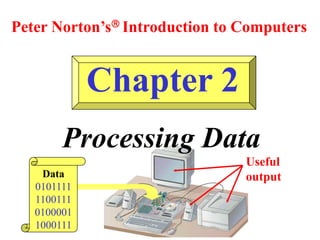
Ic lecture2
- 1. Chapter 2 Processing Data Peter Norton’s Introduction to Computers Data 0101111 1100111 0100001 1000111 Useful output
- 2. Learning Objectives: • Identify the main difference between data and information. • List two reasons why computers use the binary number system. • List the two main parts of the CPU and explain how they work together to process data. • Name three differences between RAM and ROM. • List three hardware features that affect processing speed. • Name the two best-known families of CPUs and list their differences.
- 3. Essential Computer Hardware • Processor • Memory • I/O • Storage
- 4. Processing Conversion of raw data into useful information Two basic components: • Processor • Memory For details study page 28 from Peter Norton’s Introduction to computing
- 5. Memory RAM • Temporary • Volatile • Un-programmed • Effects speed and power of PC ROM • Permanent • Non-volatile • Pre-programmed • Responsible for giving start up instructions to computer
- 6. I/O Devices Input Devices • Mouse • Keyboard • Scanner • Joystick • Light pen • Mic • Touchpad • Digital camera Output Devices • Monitor – Monochrome – Color • Printer • Plotter • Speaker • Rectangular Screens – LCD – LED – SMD Surface Mount Device – Laptop Screens (LCD / LED) • Touch Screen LCD, LED
- 7. Storage Devices • Magnetic – Floppy Disk – Magnetic tape – Hard Disk • Optical – CD (Slower in speed and less data storage) – DVD (Faster in speed with huge data storage) – Blue Ray (Fastest medium with very huge data storage)
- 8. Data - raw facts Information - meaningful data (Useful output) (Processed Data)
- 9. Number Systems: Decimal Numbers - Base 10 Notation Binary Numbers - Base 2 Notation
- 10. Bits and Bytes: •Bit = binary digit - Smallest unit of data •Byte = 8 bits
- 11. Computers represent data with electrical switches. = 1 = 0 On-off circuits are simple and are not prone to errors. 0 1 0 0 1 0 0 0 One byte is made up of 8 bits. (binary 01001000 = decimal 72) (ASCII 01001000 = the letter “H”)
- 12. Computer parts communicate using binary numbers. The greater the number of bits moved at one time, the faster the processing speed. Note: Two concepts: Serial and Parallel
- 13. Text Codes: EBCDIC “EB-si-dic” - (Extended Binary Coded Decimal Interchange Code) ASCII “As-key” - (American Standard Code for Information Interchange) Unicode - (Unicode Worldwide Character Standard)
- 14. CPU (Central Processing Unit) - the brain of the computer Two parts: • CU (Control Unit) • ALU (Arithmetic/Logic Unit)
- 15. Control Unit - Controls the flow of data into and from the Central Processing Unit.
- 16. Arithmetic/Logic Unit - Performs Arithmetic functions and Logical operations.
- 17. The CU and ALU are in the CPU.
- 18. Types of Memory: ROM - Read Only Memory (contains the basic input output system or BIOS) RAM - Random Access Memory (user programs and data go here)
- 19. The ROM is nonvolatile because it will not loose its contents when powered OFF RAM plugs into sockets on the motherboard.
- 20. Adding RAM often increases system performance.
- 21. The CPU can read RAM much faster than it can read the hard disk.
- 23. CPU Models: • 8086 1978 • 8088 1979 • 80286 1982 • 80386 1985 • 80486 1989 • Pentium 1993 • Penium Pro 1995 • Pentium II 1997 • Pantium III • Pantium IV • Dual Core • Core2duo • Core Technology • i3,i5, i7
- 24. The CPU may be i3,i5 or i7 but the generations may be different Today is the 6th Generation of Core technology
- 25. The Pentium II has 7.5 million transistors, more than double the number included on the original Pentium chip. It can operate from 233 MHz to 400 MHz and beyond. About MHz: the faster the clock, the faster the processing speed. (1 MHz = 1 million clock cycles per second)
- 26. Learning Objectives: Chapter 2 Review • Identify the main difference between data and information. • List two reasons why computers use the binary number system. • List the two main parts of the CPU and explain how they work together to process data. • Name three differences between RAM and ROM. • List three hardware features that affect processing speed. • Name the two best-known families of CPUs and list their differences.